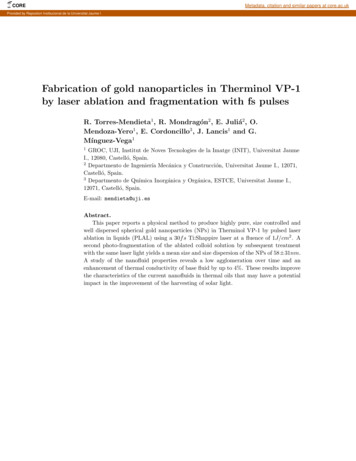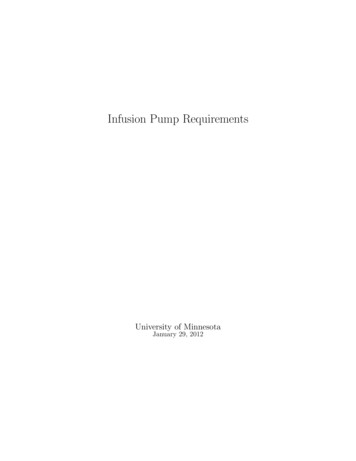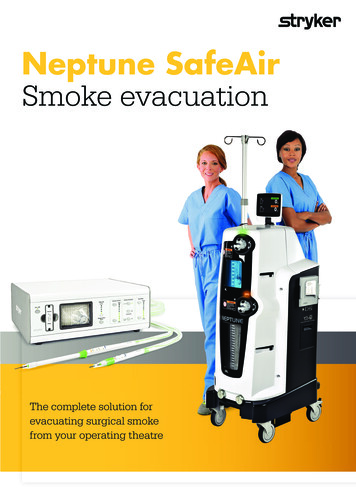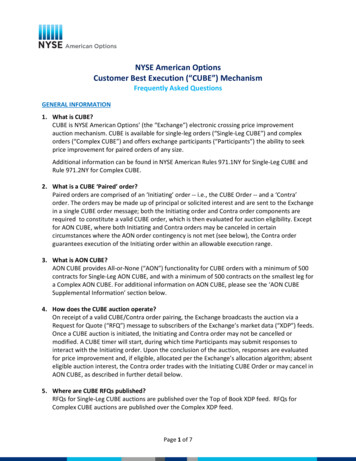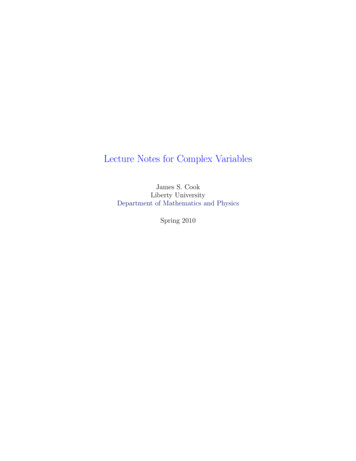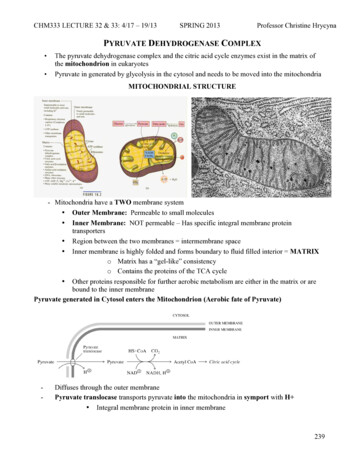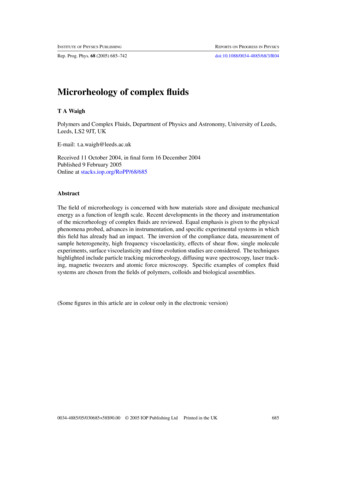
Transcription
INSTITUTE OF PHYSICS PUBLISHINGREPORTS ON PROGRESS IN PHYSICSRep. Prog. Phys. 68 (2005) gy of complex fluidsT A WaighPolymers and Complex Fluids, Department of Physics and Astronomy, University of Leeds,Leeds, LS2 9JT, UKE-mail: t.a.waigh@leeds.ac.ukReceived 11 October 2004, in final form 16 December 2004Published 9 February 2005Online at stacks.iop.org/RoPP/68/685AbstractThe field of microrheology is concerned with how materials store and dissipate mechanicalenergy as a function of length scale. Recent developments in the theory and instrumentationof the microrheology of complex fluids are reviewed. Equal emphasis is given to the physicalphenomena probed, advances in instrumentation, and specific experimental systems in whichthis field has already had an impact. The inversion of the compliance data, measurement ofsample heterogeneity, high frequency viscoelasticity, effects of shear flow, single moleculeexperiments, surface viscoelasticity and time evolution studies are considered. The techniqueshighlighted include particle tracking microrheology, diffusing wave spectroscopy, laser tracking, magnetic tweezers and atomic force microscopy. Specific examples of complex fluidsystems are chosen from the fields of polymers, colloids and biological assemblies.(Some figures in this article are in colour only in the electronic version)0034-4885/05/030685 58 90.00 2005 IOP Publishing LtdPrinted in the UK685
686T A WaighContents1. Introduction1.1. Description of the field1.2. Scope of the techniques2. Physical phenomena2.1. Introduction2.2. Generalized Stokes–Einstein equation2.3. Heterogeneity2.4. High frequency viscoelasticity2.5. Geometry2.6. Shear flow2.7. Single molecule experiments2.8. Surface viscoelasticity2.9. Time evolution3. Instrumentation3.1. Types of measurement3.2. Techniques4. Specific experimental systems4.1. Polymers4.2. Colloids4.3. Biological assemblies5. Future avenues of research6. 735736736737
Microrheology of complex fluids6871. Introduction1.1. Description of the fieldRheology is the study of the viscoelasticity of materials. Microrheology extends this definitionto consider how the dynamic behaviour of these materials changes with length scale. Theseparation of a material into ‘component’ or ‘structure’ is often artificial and morphologiescommonly exist at a whole range of length scales in complex fluids. Thus a rich rangeof theoretical and experimental questions are presented to the prospective microrheologist(MacKintosh and Schmidt 1999).Microrheology relates to the phenomena involved in the storage and dissipation ofmechanical energy in soft materials at the micrometre or sub-micrometre level (MacKintoshand Schmidt 1999). A technical hurdle for optical methods of mechanical spectroscopy istypically set at the micrometre level, which dictates the prefix in the title. There has alsohistorically been a distinct biological bias in the field, since cells operate at the micrometrelevel, providing a strong impetus to drive the research (Berg 1993).Practically microrheology has long been identified with the resolution limit of an opticalmicroscope operating at its largest degree of magnification, 0.5 µm, and optical techniquescontinue to dominate the field. However, the area is rapidly enlarging and advancing with aseries of technical and theoretical barriers being overcome. Within this enlargement there hasbeen the creation of new sub-fields which are the subject of more specialist reviews; magnetictweezers (Strick et al 2003), force microscopy (Mukhopadhyay and Granick 2001), particletracking (Tseng et al 2002a, 2002b), surface viscoelasticity (Meyer et al 1998), microfluidics(Hansen and Quake 2003) and diffusing wave spectroscopy (DWS) (Harden and Viasnoff2001). In this paper the basic universal principles of the techniques are discussed and moremodern developments are reviewed.The field of complex fluids is an emerging area of physics. It coexists with suchconventional areas as condensed matter and fluid mechanics. There is an extremely wide rangeof sample chemistries, topologies and geometries that are investigated in complex fluids, inmany ways richer and more demanding than those included under more traditional physicalclassifications. In particular, complex fluids (polymers, colloids and biological materials)are expected to demonstrate behaviour intermediate between solids (completely elastic) andfluids (completely viscous), and accurate methods are thus required to quantify the phenomenaassociated with their viscoelasticity. The industrial applications of complex fluids are vast.How do you choose the viscosity of a new shampoo in a new formulation, a drug deliverysystem as it is transported through the body, a fruit cake mixture as it experiences multiplephase transitions during cooking or a grade of cement in the construction of a new building(Larson 1999)? There is thus a wide range of fields that will benefit from new rheologicalprobes driving the current research.Microrheology is closely connected to the field of microfluidics, which considers suchphenomena as those involved in ink jet printing, microelectrophoresis on a chip, microvalves,and the kinetics of protein crystallization (Hansen and Quake 2003). The change of emphasis,which separates the two fields, is the extension to the consideration of viscoelasticity withmicrorheology. The overlap is thus quite strong and the fluid mechanics of materials in confinedgeometries is a common area to the two research fields.The subject of biological motors has recently been revolutionized by new microrheologytechniques (Howard 2001). The understanding of the viscoelasticity of the motors at themolecular level has been improved, which directly relates to questions of muscular dysfunctionvitally important to the medical industry. Intensive research funded from studies into
688T A Waighcardiac disease with optical/magnetic tweezers and atomic force microscopy (AFM) has beentransferred to more general areas of complex fluids research.There is a long history of colloidal probe particles (Mhetar and Archer 1996) being usedas tracers to define flow kinetics in engineering studies of bulk viscoelastic materials. Herea number of assumptions are made; the probe particles are isokinetic with the motion of thematerial investigated, there are no interparticle interactions involved between the probes, andthere is no restructuring of the viscoelastic material by the probes (Solomon and Lu 2001). Theexperimental situation with these tracer studies is thus much more complicated than typicallyfound with particle tracking microrheology (PTM) and many of these assumptions need to berevisited if engineers wish to quantify their measurements in more detail.1.2. Scope of the techniquesHistorically the roots of microrheology can be found in the observation of the Scottish biologist,Robert Brown (1827) that pollen grains (his probe particles) moved incessantly on the surfaceof water. This phenomenon at first sight appears abnormal; what is the origin of the forcedriving the motion? Such behaviour was later theoretically analysed by Albert Einstein(1905), who established the molecular nature of matter by explaining Brown’s results in termsof a statistical analysis of the collisions of pollen with the surrounding solvent molecules.The calculations of Einstein were subsequently shown to be quantitatively correct by thepainstaking experiments of Jean Baptiste Perrin (1948). Perrin demonstrated that the meansquare-displacement (MSD) of 0.37 µm gutta-percha particles in water is directly proportionalto time with a constant of proportionality that describes the frictional dissipation of the particles.Another historical land mark is seen in early attempts to create active magnetic microrheometersto manipulate micrometre-sized ferromagnetic particles (Crick and Hughes 1950), althoughthe first suggestion of such a device is much earlier (Seifriz 1924). After a period of relativeinactivity, there followed modern developments such as particle tracking video-microrheology(Mason et al 1997), AFM (Mahaffy et al 2000), DWS (Pine et al 1988) and optical tweezers(Starrs and Bartlett 2003). These methods have principally been driven by the availability ofcheap computing power and intense coherent monochromatic light sources (lasers).In the present day, the case for microrheology as a new analytical technique for complexfluids is very strong. For the simplest available technique, PTM, the apparatus is relativelycheap ( 10 k), and sufficiently simple that internationally competitive apparatus can beadapted and constructed without advanced technical ability. Some of the specific advantages ofmicrorheological methods will be enumerated to make a clear case for the range of techniquesthat are reviewed and to emphasise some unifying features:(1) Combinatorial chemistry. Microrheology allows the rapid characterization of microlitrequantities of material, enabling detailed phase diagrams to be quickly established (Amisand Schubert 2004, Breedveld and Pine 2003). An order of magnitude increase inthroughput has recently been demonstrated with particle tracking of viscoelastic peptides,when compared with previous bulk rheology measurements. Further increases inthroughput are possible, that will scale with improved computing speed in the case oftracking experiments (Breedveld and Pine 2003). Microrheology presents an ideal methodfor probing permutations of reactants during the synthesis of a new viscoelastic material.(2) Agreement with bulk values. Measurements obtained on expensive low shear rate solutionrheometers have been shown to agree with those taken on budget microrheology equipmentwith a subset of complex fluids (see section 2.3). A consensus on how the sample chemistryand heterogeneity relate to the question of micro/bulk agreement needs to be constructed
Microrheology of complex fluids(3)(4)(5)(6)(7)(8)(9)(10)689in full, but there are good prospects that the range of overlap can be improved usingtwo-particle cross-correlation techniques (Crocker et al 2000).High frequency response. The low inertia of colloidal probe particles allows themeasurement of the high frequency response of soft materials with methods such as DWS(Mason and Weitz 1995) and optical tweezers (Schnurr et al 1997). There are no prospectsfor such large frequency windows being developed with conventional bulk rheometers dueto the large forces and torques required.Minimization of sample volumes. Reducing the amount of viscoelastic material necessaryto perform a measurement of a complete viscoelastic spectrum causes a concurrentreduction in cost and increase in the flexibility with which the sample geometry can bechosen. For example, the characterization of specimens from medical trials necessitatesthe use of minute histology samples and microrheology could provide a diagnostic methodin these cases.Length scale. The viscoelasticity can be characterized as a function of length scale withinthe sample. Complex fluids typically exhibit hierarchical structures on a series of separatelength scales and measurements at each scale would enable a complete picture of theirviscoelasticity to be developed. Specifically, techniques such as particle tracking videomicroscopy, optical/magnetic tweezers and AFM, allow the viscoelasticity to be quantifiedas it varies from point to point (Tseng and Wirtz 2001).Sizing of particles. This can be performed using microrheological measurements andoffers a method for characterizing the molecular structure of a complex fluid. The intrinsicviscosity of the solution is plotted against the particle concentration and subsequentanalysis can provide a radius of gyration for the particles (Goodman et al 2002). Thisprocess could compete with other standard methods of particle characterization such aslight scattering techniques (Chu 1991) and bulk viscometry (Kulicke and Clasen 2004),since it requires much smaller sample volumes, i.e. microlitres compared with millilitres.Phase diagrams. Measuring the viscoelasticity rapidly at a wide range of concentrationsallows phase diagrams to be mapped. Modern scaling theories allow these phase diagramsto be motivated for a range of complex fluids and microrheology offers a relatively fastroute for their determination. Investigations are not restricted to the sample chemistry;new insights into the physics are also possible, e.g. the dynamic modes that controlthe viscoelasticity of a polymer solution: Zimm, Rousse, sticky Rousse, or reptation(Rubinstein and Colby 2003).Cellular function. Microrheological techniques provide new methods for probingintracellular function. Many cellular processes involve changes in the viscoelasticityof biomaterials at the micron level such as phagocytosis and motility. Microprobes can beintroduced into living cells to quantify their motility without completely disrupting theirfunction (Lau et al 2003).Delicate probes. Thermal energies ( kT ) on colloidal particles provide a delicate probe ofthe structure and dynamics of fragile soft condensed matter systems. Materials which aredamaged during measurement on bulk rheometers often fare better with microrheologicaltechniques, which typically apply forces on the order of a few piconewtons. It is thenpossible to be certain that measurements are in the linear rheological regime.Single molecule experiments. The theoretical analysis of the fluctuation spectra ofmicrometre sized probe particles relates directly to a range of single molecule forcespectroscopy techniques. For example, microrheology experiments are required tocalibrate optical/magnetic tweezers and atomic force microscopes in such studies.Furthermore a second generation of single molecule experiments are investigating thedynamics of soft condensed matter systems on an individual molecular basis. Rheological
690T A S100Atomic Force Microscopy1000Video ParticleTrackingFrequency Range 0.1LaserTracking1TransmissionDWS10Video Particle TrackingViscoelastic Moduli (Pa)100Atomic Force Microscopy(b)0.00001Figure 1. Typical ranges of the (a) frequency and (b) shear modulus (G , G ) calculated inmicrorheology techniques during measurement of the linear viscoelasticity of complex fluids. Theresponse at low moduli has not been investigated in detail except with video particle tracking.concepts are required to understand the response of these viscoelastic specimens (Okajimaet al 2004).Before entering into a discussion of specific experimental techniques, it is useful to tryto get a broader outline of the range of frequencies and moduli that can be measured. Forexample, how is it possible to measure the linear viscoelastic spectrum of a new specimenof a complex fluid (figure 1)? Here there is a sharp dichotomy between passive and activemicrorheological techniques, where the probe particles are subjected to thermal energy or an
Microrheology of complex fluids691external field, respectively. Passive techniques are typically more useful for measuring lowvalues of predominantly viscous moduli, whereas active techniques can extend the measurablerange to samples containing significant amounts of elasticity.It is instructive to compare microrheology with the field of inelastic scattering, which is astandard method for studying the wide range of dynamic processes that occur in complex fluids.Inelastic and quasi-inelastic scattering of light (Berne and Pecora 2000), x-rays (Grubel andZontone 2004) and neutrons (Higgins and Benoit 1994) provide complementary informationto rheological studies. The common bond between microrheology and scattering is that bothallow non-invasive measurements of the time response of fragile complex fluids. This is not truewith many electron/x-ray/confocal microscopy, and bulk rheological methods. Furthermoreboth microrheology and scattering offer a length scale sensitive measure of the dynamics ofcomplex fluids. Microrheology is starting to compete on this front with inelastic scatteringtechniques, in contrast to previous bulk rheological methods, which typically provide timeaveraged measurements over many millilitres of material. Rheological measurements havethe advantage that they quantify how materials store and dissipate energy, and thus directlyrelate to every day macroscopic observables, whereas scattering methods are connected withless physically tangible intensities in reciprocal space.2. Physical phenomena2.1. IntroductionIt is useful to consider some of the general principles of the physics which underpin themicrorheological techniques described. A rich variety of phenomena are observed in lowReynolds number dynamics. The phenomena have has been investigated in detail in molecularbiophysics with respect to the motility of cells and microorganisms. The reader is directedto two clear and insightful pedagogic accounts (Berg 1993, Purcell 1977) for an introduction.The low Reynolds number approximation to the dynamics of small colloidal particles can oftenbe invoked in microrheology experiments and can be crucial to provide tractable data analysis.The Reynolds number for the motion of a small particle in a fluid ( , inertial force/frictionforce) is given by:νRρm ,(1)ηwhere η is the viscosity of the fluid, ν is the particle velocity, R is the particle radius and ρm isthe relative density. This dimensionless group ( ) determines when it is possible to neglect theinertial force terms (m dv/dt 0) in a particular system. From a basic analysis of Newton’ssecond law for a particle moving in a viscoelastic material (mass m), the simplified equationof motion (no viscoelastic memory) isdv(t)dx(t) FSto (t) γ κx(t),(2)mdtdtwhere Fsto (t) is the stochastic thermal force acting on the system, γ is the drag coefficient, κ isthe elastic constant, and x(t) is the displacement of the particle as a function of time. It can beshown that in most passive microrheological experiments the viscous forces of the surroundingmedium dominate the dynamics of the probe particles and the particles will coast to a halt ina few Angstroms if there are no forces actively driving their motion (Berg 1993). Althoughthe average particle displacement of the probes is zero, they are constantly fluctuating due tothermalized collisions with surrounding solvent molecules, x 2 (t) 0.The buoyancy of the probe particles is another important practical factor to be consideredin making accurate rheological measurements. The particle dynamics need to be examined
692T A Waighunmodified by the effects of sedimentation, far away from the perturbing effects of boundaries,to perform meaningful measurements. For example, probe particles dropping into and out of theplane of detection in particle tracking experiments can introduce high levels of low frequencynoise drastically reducing the quality of measurements.Using Archimedes principle, the effective mass (m ) of a particle suspended in a fluid isgiven by its actual mass (m) minus the mass of the fluid it displaces (particle volume (V ) fluid density (ρ)).m m Vρ.(3)The number density of the particles N (z), as a function of their height (z) above thebottom of the container, is given by a Boltzmann distribution when the particles are in thermalequilibrium (Berg 1993).N (z) e m gz/kT ,(4)N (0)where z is the height of the particles, m is the mass adjusted for the buoyancy, N (0) is theparticle density when z is 0, g is the acceleration due to gravity and kT is the thermal energyscale. The concentration of probe particles in a container will thus change exponentially withheight in thermal equilibrium.The velocity (vsed ) adopted by the particles as they sediment also needs to be considered,i.e. the rate at which they approach equilibrium (Berg 1993). A simple analysis of the equationof motion of a non-interacting single particle in a purely viscous fluid gives an expression forthe sedimentation velocity2a 2 m g,(5)9V ηwhere a is the particle radius, η is viscosity, g is gravity, and V is the particle volume.For example, a polystyrene sphere of 1 µm radius and specific gravity ρs 1.05 g cm 3(iron oxide particles have densities as high as 5.2 g cm 3 ) will sediment in water with a velocity(vsed ) of 1.1 10 5 cm s 1 . It will take about 2 h for such spheres to sediment 1 mm makingtracking experiments in water possible. In contrast iron oxide particles require only 1 minto travel this distance making passive techniques difficult with such probes. It is a tacitassumption that low rates of sedimentation (vsed ) do not affect the fluctuation spectra measuredin the perpendicular directions in PTM experiments and thus dense particles can be used formeasurements in highly viscous materials. There continue to be a series of theoretical questionsin the hydrodynamics of sedimentation that are not well understood (Dufresne et al 2000).The question of buoyancy in PTM sets a number of experimental challenges; how are theprobe particles to be prevented from dropping out of solution or how can the experiment beperformed before this happens? One solution is to increase the viscoelasticity of the materialsexamined, but this can cause problems if the probe fluctuations are reduced below a detectablelevel. An ideal solution is when the sedimentation can be adjusted with an applied potentialin situ with active microrheology techniques, such as optical and magnetic tweezers (Gosseand Croquette 2002, Starrs and Bartlett 2003). An optical or magnetic force can thus be usedto balance the gravitational force.Diffusion is a process whose conceptual complexity is often underestimated by a superficialexamination of the basic mathematics involved. The diffusion coefficient in two dimensions(calculated, for example, by a time series of digitized camera images) of a particle in a purelyviscous fluid allows the amplitude of particle fluctuations to be quantified.The mean square fluctuation of a particle in n dimensions (Berg 1993) ( r 2 ) dependslinearly on time (t) with a proportionality constant D defined to be the diffusion coefficientvsed
Microrheology of complex fluids693for translational motion r 2 2nDt(6)and r 2 rx2 ry2 in two dimensions (n 2), the sum of the mean square fluctuations inthe x and y components of the MSD.The linear time dependence r 2 t α , with α equal to 1 in equation (6), corresponds tothe case of diffusion in a purely viscous material, e.g. water or glycerol. Introducing an elasticelement in the complex fluid causes the value of the exponent to reduce at short times andsub-diffusion is observed, α 1. Quantitative analysis of this subdiffusive motion can allowthe calculation of the rheological properties of the material and this is the key concept behindmany of the microrheological techniques that will be discussed (section 2.2).The diffusion coefficient (D) of a probe particle (units cm2 s 1 ) can be calculated from thefluctuation dissipation theorem in its simplest form i.e. it is inversely related to the frictionalcoefficient (f ) of the particle scaled by the thermal energy (kT )D kT,f(7)where f for a colloidal sphere can be calculated from Navier–Stokes equations and is given by:f 6πηrh(8)and thus the Stokes–Einstein relationship can be formed by combining equations (7) and (8)D KT,6πηrh(9)where η is the viscosity of water, rh is the hydrodynamic radius and kT is the thermal energy.Rotational diffusion can also be considered in a similar fashion to translational motion tostudy the response of a complex fluid. In this case the fluctuations in the rotational displacementof a particle in three dimensions are given by the formula θ 2 6Dθ t,(10)where θ 2 is the mean square fluctuations in the angle of rotation of the particle, Dθ is therotational diffusion coefficient (units s 1 ) and t is the time.For a rigid sphere with stick boundary conditions, the rotational diffusion coefficient (Dθ )can be calculated by the fluctuation dissipation theorem equation (7), where in this case therotational frictional coefficient (f ) is 8π ηrh3 .Dθ kT,8πηrh3(11)where η is the viscosity, and kT is the thermal energy. The dependence of the rotationalfluctations on time become sublinear with the introduction of an elastic component in thematerial, in a similar manner to translational fluctuations.The fluctuation spectra of minute particles embedded in a complex fluid are thus seento be a measure of its viscoelasticity. The next challenge covered in section 2.2 is how tobridge the gap from the microscopic behaviour to macroscopic measures of viscoelasticity(G , G , J (t), etc). The relevant measures of bulk viscoelasticity are described in detail insection 3.1. Although the emphasis is often made in microrheology on the measurementof shear moduli (G , G ), it is also possible to examine longitudinal moduli (E , E ) withmicrodynamic mechanical testing apparatus (µDMTA), i.e. AFM.
694T A Waigh2.2. Generalized Stokes–Einstein equationA recurrent question in the analysis of the fluctuation spectrum of particle displacement inpassive microrheology experiments is how to transfer between the compliance (proportionalto the mean square amplitude of the particle fluctuations, equation (34)) as a function of timeand the linear viscoelastic spectra (shear modulus) as a function of frequency. Measurement ofa wide time range is required to provide the corresponding width in frequency space. A numberof different methods are indicated in the literature for calculating this transformation and it isa well-defined class of mathematical ‘inverse problem’, having general features in commonwith such classic techniques as the Fourier transform (Bracewell 1986).Historically the generalized Stokes–Einstein (GSE) equation was initially put forward onan ad hoc basis to analyse the thermal fluctuation spectrum of probe spheres (Mason and Weitz1995). It was later placed on firmer theoretical foundations (Levine and Lubensky 2000). Thealgebraic form resembles that of the Stokes–Einstein equation (9), although it now involvesLaplace transformed quantitieskT,(12)D̃(s) 6πas η̃swhere a is the radius of the probe sphere, η̃s is the Laplace transformed frequency dependentviscosity, D̃(s) is the Laplace transformed frequency dependent diffusion coefficient and s isthe Laplace frequency.The GSE equation applied to colloidal hydrodynamics is thought to be valid if the inertialeffects of the probe particles, the inertial effects of the fluid and the longitudinal compressionmode of the fluid can all be neglected over the frequency range of the measurements. Theeffect of the particle inertia is shown to be negligible if the frequency obeys the inequality(Levine and Lubensky 2000) 9G(ω) 1/2,(13)ω 2a 2 ρfwhere G(ω) is the frequency dependent shear modulus, a is the particle radius, and ρf is thedensity of the particle. This introduces an upper bound on the frequency of a measurement,on the order of 10 MHz in a typical system (polystyrene spheres of 0.2 µm diameter inpolyethylene oxide (PEO) solutions).Similarly, the fluid inertia can be neglected if the measurement frequency obeys theinequality 1/2 2π G(ω).(14)ω 4a 2 ρfThis frequency is again on the order of 10 MHz.The longitudinal compressive modes are typically on the order of 10 Hz for a polymericmaterial providing the lower frequency limit of the measurements. Thus there is a widefrequency range over which the GSE can be used with accuracy for colloidal hydrodynamicsin practical situations (10–107 Hz).Although they are in principle equivalent for well-defined MSD data sets, it is useful tomake a comparison of the different inversion methods, which are required in order to transferbetween the shear moduli and the compliance. Figure 2 shows a graphical representation ofthe possible methods of data inversion. Fourier transform methods (power spectral density r 2 (ω) ) may be useful for data sets over a wide range of frequencies with a wide range offeatures (Schnurr et al 1997). However for the limited data sets typically encountered inpractice with microrheology experiments the numerical method using analytic continuation is
Microrheology of complex fluids r2(s) UnilateralLaplaceTransform695 GSEG( s)Mason’snumericalform (1)Inverse Laplacetransform or relaxationspectrum (2) r2(t) MeasuredMSDPower SpectralDensity(Bracewell1986) r2(ω) Analyticcontinuation(Masonet al 1996)G(t)Stress relaxationmodulusKronig-Kramersand fluctuationdissipation theory(Schnurr et al 1997)Unilateral FourierTransformG*(ω)Complexshear modulusFigure 2. Possible methods of data inversion to provide the complex viscoelastic shear moduli(G , G ) from the compliance (or mean-square particle fluctuations r 2 (t) ). s is the complexLaplace frequency, and ω is the experimental frequency.(1) Mason and Weitz’s numerical form for the shear modulus as a function of frequency(Mason 2000) 2kT ,G(ω) 223πa r (τ ) (1 (d ln r (τ ) /d lnτ )) τ 1/ωwhere kT is the thermal energy, a is the probe radius, r 2 (τ ) is the MSD calculated at frequencytime τ 1/ω and is the gamma function.(2) The shear modulus (G(s)) as a function of the Laplace frequency (s) can be fit to thefunctional form Gj s ,s 1/τjjG(t) is reconstructed as the sum of exponentials amplitude Gj and time constant τj .becoming a standard tool (Mason et al 1997), since the Fourier transform method can providenoisy data with spurious high frequency fluctuations (Schnurr et al 1997). The Provencheralgorithm is a readily available robust implementation of a numerical inverse Laplace transform,to construct the stress relaxation modulus from G̃(s) (equation (12)), but analytic continuationis a faster tool for smooth data sets with few distinct features (Mason 2000).The GSE equation in terms of the Laplace-transformed modul
Polymers and Complex Fluids, Department of Physics and Astronomy, University of Leeds, Leeds, LS2 9JT, UK E-mail: t.a.waigh@leeds.ac.uk Received 11 October 2004, in final form 16 December 2004 Published 9 February 2005 . calibrate optical/magnetic tweezers and atomic force microscopes in such studies.
